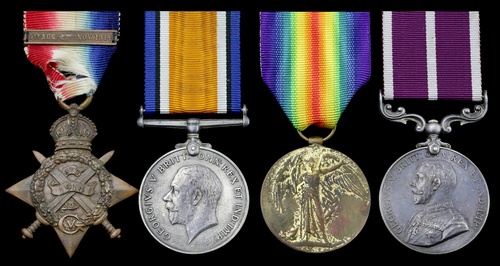
Auction: 20001 - Orders, Decorations and Medals - conducted behind closed doors
Lot: 737
The superb Great War 'Old Contemptible's' M.S.M. group of four awarded to Flying Officer W. J. Smyrk, Royal Flying Corps, decorated for his outstanding services as Technical Sergeant-Major of 60 Squadron; revered as 'a wizard with an internal combustion engine,' Smyrk kept Albert Ball V.C. and his fellow pilots airborne during the toughest fighting on the Western Front
1914 Star, with clasp (253 Cpl. W. J. Smyrk. R.F.C.); British War and Victory Medals (253. T.S.M. W. J. Smyrk. R.F.C.); Meritorious Service Medal, G.V.R. (253 A.S.Mjr: W. J. Smyrk. R.F.C.), original ribands, nearly extremely fine (4)
M.S.M. London Gazette 1 January 1918.
William Joseph Smyrk was born at 32 Henry Street, Clerkenwell in 1892. The son of Joseph Smyrk, a public bath attendant, he spent his childhood experimenting with aero models and kites. He gained civilian employment at the Gramophone Company's factory at Hayes before joining No. 1 Squadron, Royal Flying Corps on 29 July 1912. Smyrk took part in the celebrated August 1912 Military Trials, designed to test aircraft for suitability in war, flying with S. F. Cody in his aircraft Cathedral Express. Built of bamboo struts lashed together with string and painted with shellac, this aircraft was meticulously serviced by Smyrk, who oversaw both the engine and rigging. To Smyrk's great credit, Cathedral Express unexpectedly won the trials and shot S. F. Cody to fame.
At outbreak of the Great War Smyrk was serving as a Corporal in No. 6 Squadron, which arrived in France on 9 October 1914. Promoted to Sergeant, in 1915 he transferred to No. 60 Squadron (Albert Ball V.C.'s Squadron). Smyrk was responsible for servicing aero engines, and he would certainly have worked on Albert Ball's aircraft. Sixty Squadron RAF refers to him by name as 'a wizard with an internal combustion engine.' He became Acting Sergeant-Major of 60 Squadron on 1 January 1916, his knowledge in great demand. He trained the squadron's fitters and gave them weekly lectures on technical subjects. On 11 December 1917 he gave a talk entitled 'Engines: An Elementary Lecture Explaining their Working Functions', and a week later he lectured on the different parts of a Hispano Suiza Engine. Sixty Squadron RAF continues:
'During almost all of the war, two fitters a month had to be sent home to assist in the manning of new units, while the squadrons in the field had, in consequence, always to carry a percentage of untrained or partially trained men, who had to be made into experts on the engines with which they were equipped. The technical sergeant-major had to train these men, and was also the specialist who was called in whenever one of the flights had an unusually refractory engine which had baffled both the flight commander and his flight sergeant. Smyrk was always equal to every call upon him, and a long line of pilots should, and no doubt do, remember him with gratitude, for, after all, the degree of efficiency with which the engine was looked after often meant the difference between a landing in Hunland and getting home.'
Smyrk undoubtedly saved the lives of numerous pilots of 60 Squadron; his technical brilliance was recognised by the award of a Meritorious Service Medal, announced in The Times on 5 January 1918. During the Second World War he served in the R.A.F.'s Administrative and Special Duties Branch. He was gazetted Acting Warrant Officer on 25 July 1941, Pilot Officer on 4 July 1942, and Flying Officer on 4 December 1942. On 2 June 1943 he was mentioned in dispatches; sold with copied research and MIC.
Sold with a copy of I. McInnes and J. V. Webb's A Contemptible Little Flying Corps (London, 1991).
For the awards of the recipient's brother, see Lot xxx.
Subject to 20% VAT on Buyer’s Premium. For more information please view Terms and Conditions for Buyers.
Sold for
£2,100
Starting price
£950




